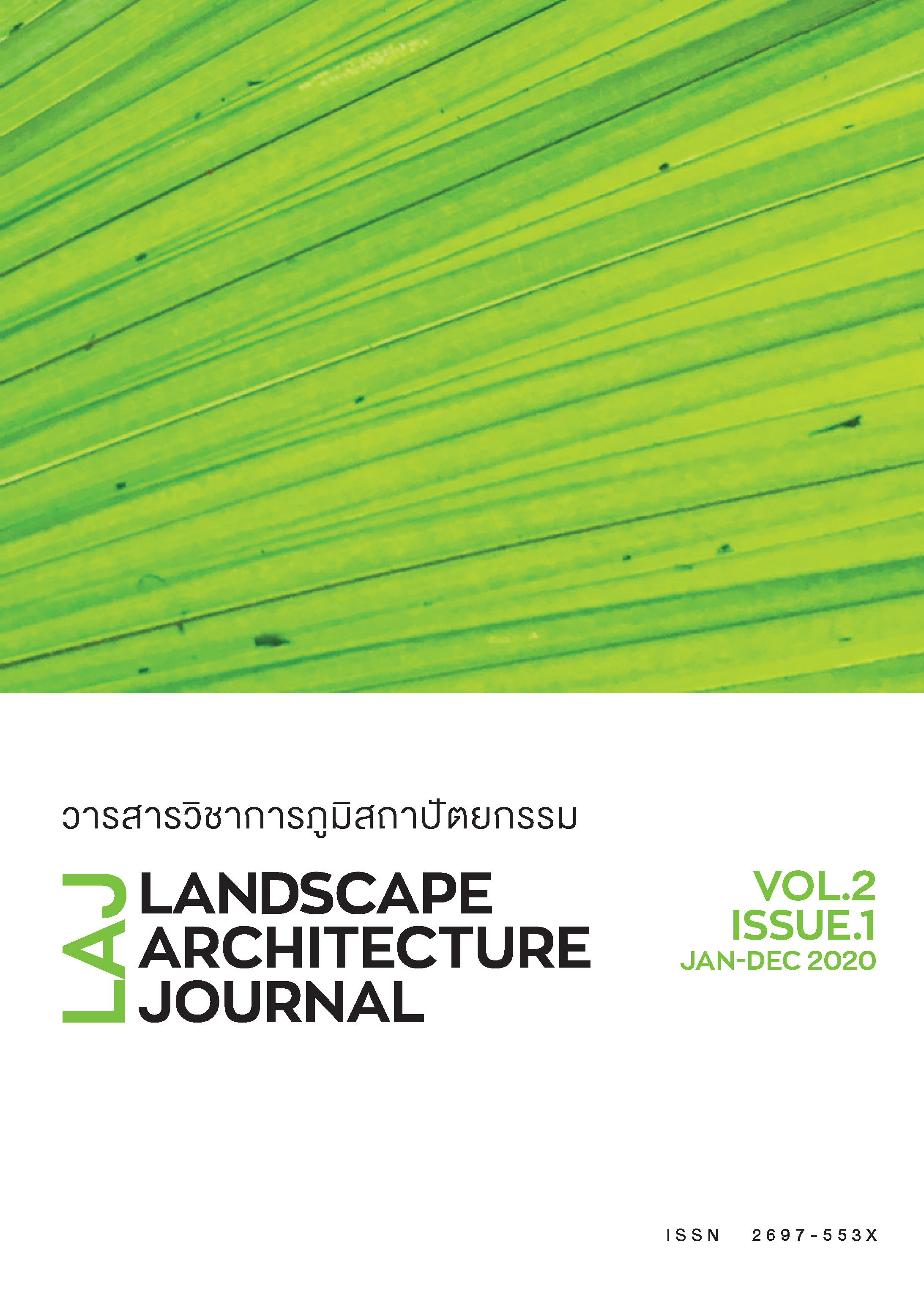An Eco-University and Stormwater Management Concepts in the Landscape Architecture: A Case Study of Faculty of Architectural and Environmental Design, Maejo University
Main Article Content
Abstract
Maejo University has a 100-year transitional master plan, which will develop the university
towards the goal of being an eco-university (GO Eco). Stormwater management in landscape architecture is one of the issues in developing a project that takes into account the situation of climate change for the world experiencing floods and drought in many areas. Stormwater management, therefore,should be considered in the master plan in response to the university policy.
The study set up the Faculty of Architecture and Environmental Design of Maejo University
as a pilot project and a case study. Based on a study of the location area of the faculty, size 15,517
square meters when classified by a soil covering type affecting water seepage, it was found that
50.98% of the land cover was impervious surfaces, 49.02% was pervious surfaces are considered high compared to 30% of the government’s green space policy.; therefore, it is proposed the concept of stormwater management on adding a water-permeable surface, collecting rainwater for use and comparing the maximum runoff in the area before and after the conceptual development. Phase 1, the water-permeable surface should be increased by changing the flat slab to an extensive roof garden. This can reduce the maximum runoff amount of rainwater by 13.43 percent and create a rain garden to help retard the rain from the roof before flowing into the natural drainage channel. Phase 2, some thoroughfares should be reduced to green areas that the water can penetrate. Change the drainage system from the road directly to the natural water source. The water should be drained through the filter strips to help reduce contaminants flowing to natural water sources. This can reduce the maximum amount of runoff water by 35.22 percent. Phase 3, the rain harvesting system from the roof should be increased by collecting 2,820.36 cubic meters per year and it can be used for watering 1,280 square meters of plants per year. It is expected that this case study can be an important role model for the university development towards being an eco-university.
Article Details

This work is licensed under a Creative Commons Attribution-NonCommercial-NoDerivatives 4.0 International License.
References
กองกายภาพและสิ่งแวดล้อม สำนักงานมหาวิทยาลัยแม่โจ้. (2563). หนังสือกองกายภาพและสิ่งแวดล้อม สำนักงานมหาวิทยาลัย ที่ อว 69.2.6/ว60 ลงวันที่ 7 พฤษภาคม 2563 เรื่อง ขอความร่วมมือประหยัดน้ำประปา และงดใช้น้ำประปาเพื่อใช้ในกิจกรรมด้านการเกษตร. เชียงใหม่: มหาวิทยาลัยแม่โจ้
เดชา บุญค้ำ. (2553). หลังคาเขียวกับภาวะโลกร้อน. วารสารการแพทย์แผนไทยและการแพทย์ทางเลือก, 7(1), 5-16. สืบค้นจาก https://he01.tci-thaijo.org/index.php/JTTAM/article/view/139015
มหาวิทยาลัยแม่โจ้. (2563). แผนแม่บทการเปลี่ยนผ่าน 100 ปี มหาวิทยาลัยแม่โจ้ 2477-2577. สืบค้นจาก https://www.mju.ac.th/main/About_Page/Strategic%20plan-mju100y.pdf.
มหาวิทยาลัยอินโดนีเซีย. (2560). คู่มือการจัดอันดับมหาวิทยาลัยสีเขียวโลก ยูไอกรีนเมตริก (UI GreenMetric). สืบค้นจาก http://greenmetric.ui.ac.id/wp-content/uploads/2015/07/UI-GreenMetric-Guideline-2017_Thai.pdf.
วิกานดา วรรณวิเศษ. (2558). การเปลี่ยนแปลงสภาพภูมิอากาศ : ผลกระทบต่อประเทศไทย. สืบค้นจาก http://library.senate.go.th/document/Ext10567/10567795_0002.PDF.
สถาบันอาคารเขียวไทย. (2560). เกณฑ์การประเมินความยั่งยืนทางพลังงานและสิ่งแวดล้อมไทย สำหรับอาคารระหว่างใช้งาน. สืบค้นจาก https://www.tgbi.or.th/uploads/trees/เกณฑ์%20TREES-EB_160921.pdf.
อริยา อรุณินท์. (2559). การออกแบบและเทคโนโลยีการก่อสร้างภูมิสถาปัตยกรรม. กรุงเทพฯ: สำนักพิมพ์แห่งจุฬาลงกรณ์มหาวิทยาลัย.
Arlington County. (2013). Stormwater & Watersheds. Retrieved from https://environment.arlingtonva.us/wp-content/uploads/sites/13/2013/10/Impervious-Surfaces-Diagram.jpg.
Boults, E., & Sullivan, C. (2010). Illustrated History of Landscape Design. New Jersey: John Wiley & Sons, Inc.
Cheshmehzangi, A., & Butters, C. (2015). Urban Green Infrastructure: for Cities of Developing Countries. Retrieved from https://butters.no/wp-content/uploads/publications/2016.THAI%20language%20version%20Green%20Infrastructures.AC+CB.Mar%202016.pdf.
Eniscuola energy & environment. (2017). Road runoff and environmental pollution. Retrieved from http://www.eniscuola.net/en/2017/03/22/road-runoff-environmental-pollution/.
Harris, W. C., & Nicholas, T. D. (1995). Time-saver standards for landscape architecture. International edition. Singapore: McGraw-Hill.
Melbourne Water. (2017). Introduction to WSUD. Retrieved from https://www.melbournewater.com.au/building-and-works/stormwater-management/introduction-wsud#close.
United States Environmental Protection Agency. (2018). Best Management Practices (BMPs) Siting Tool. Retrieved from https://www.epa.gov/water-research/best-management-practices-bmps-siting
-tool.
United States Environmental Protection Agency. (2020). Urban Runoff: Low Impact Development. Retrieved from https://www.epa.gov/nps/urban-runoff-low-impact-development.

